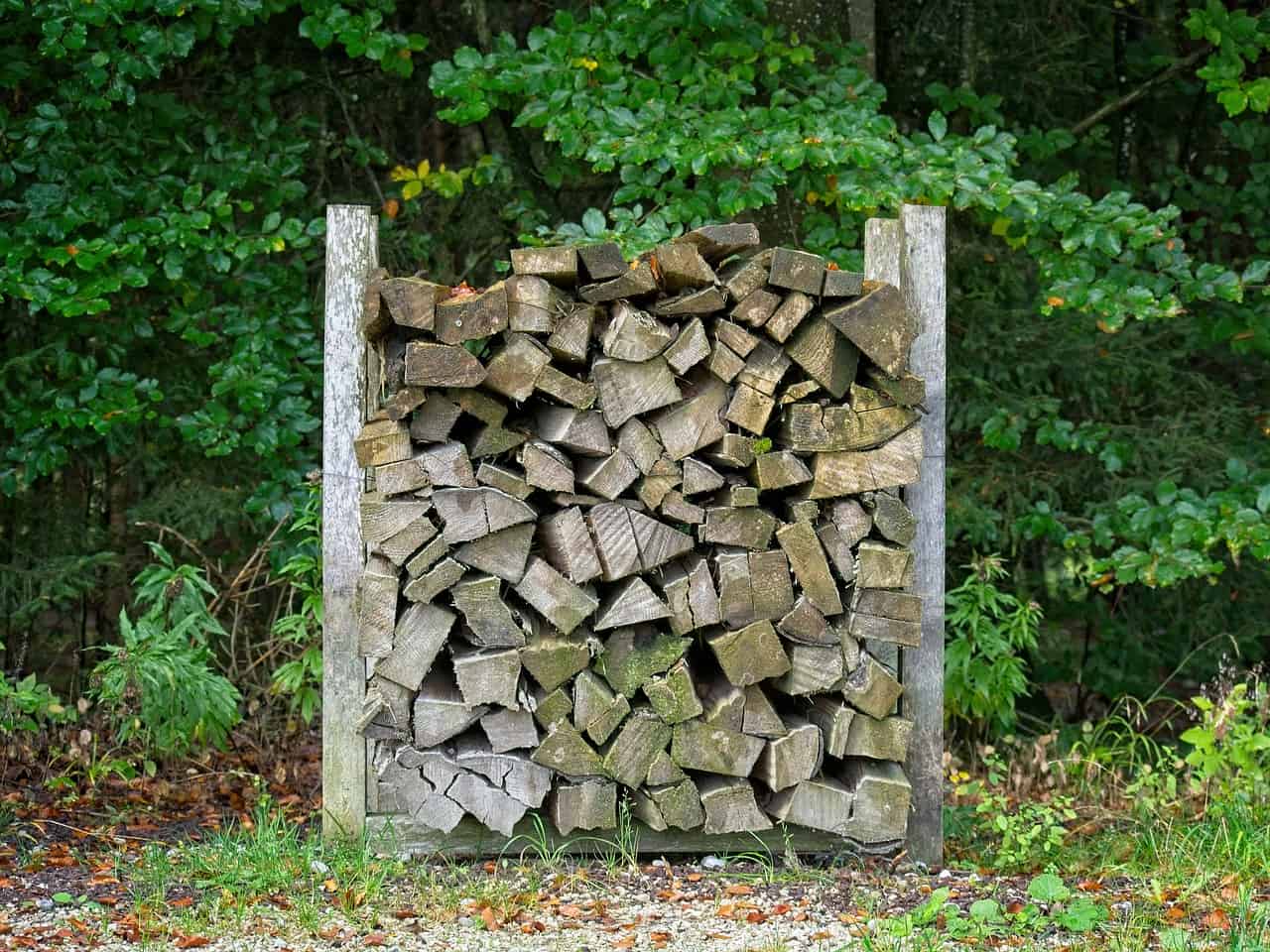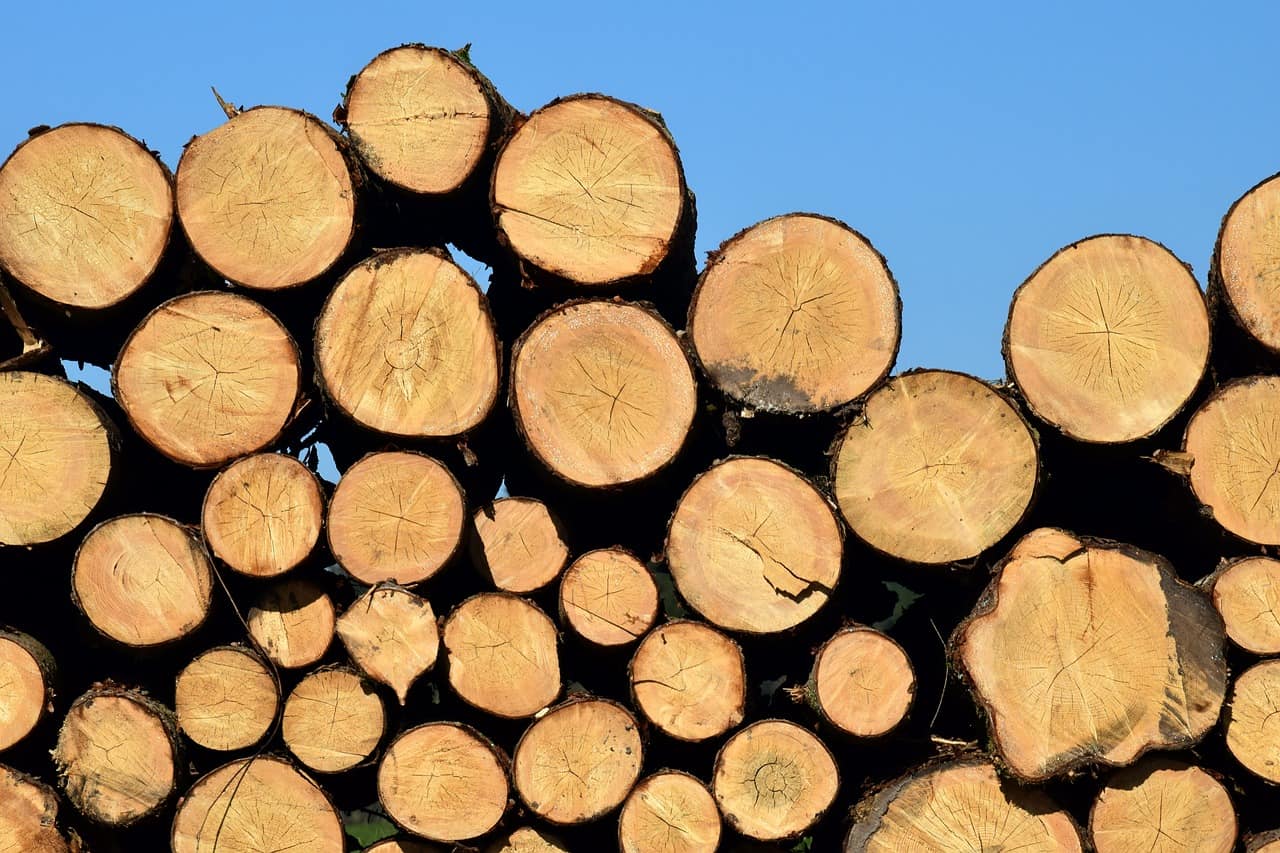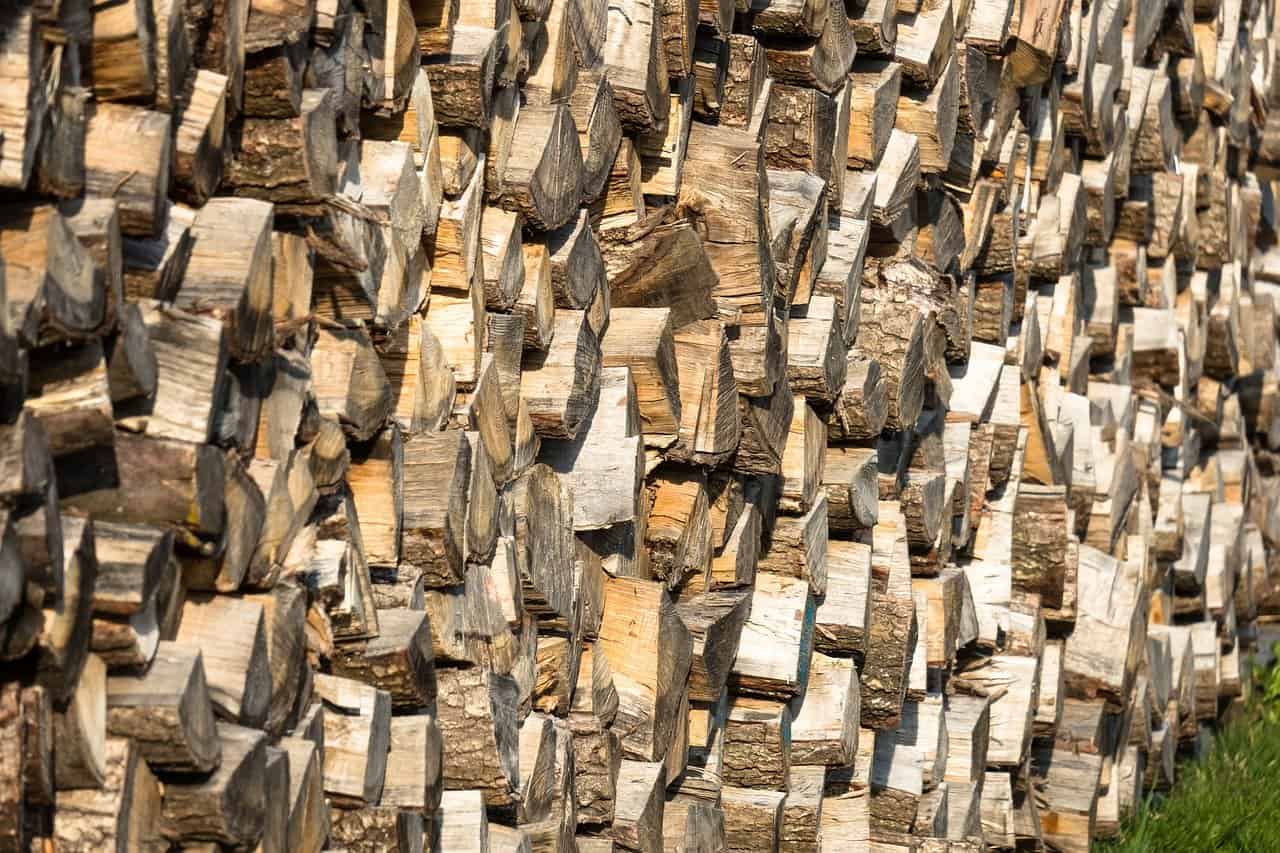- Best STIHL Brush Cutter Replacement Blade - December 8, 2023
- Box Elder Wood Uses - September 30, 2022
- Hackberry Wood Uses - September 25, 2022
After a hard day cutting trees your reward is a haphazard pile of logs. The last thing you want to do is to stack the logs neatly. Here I’m going to provide some Firewood Storage ideas and solutions in transforming your pile of logs into a neat and efficient stack.
First, we need to cover some of the basic essentials in seasoning your load of firewood. Freshly cut trees will have a fairly high moisture content. Storing the cut logs aims at reducing the moisture content to below twenty percent.
Nature is always striving for balance. That is the driving force in seasoning firewood. Exposing logs to allow nature to reduce the moisture content to the ambient level. Stacking logs correctly is simply storing them in such a way that nature can dry them as efficiently as possible.
Why The Twenty Percent Rule?

We have all experienced a fire that has been more smoke than heat. Wet wood will burn reluctantly and while doing so it will make a lot of smoke. The heat produced in burning wet wood is significantly reduced because a substantial amount of energy is being consumed in evaporating the moisture.
What you end up with is a smoky fire of limited heat. Burning wet wood will also result in your chimney quickly filling up with residue and creating a fire risk.
That is why it is essential to season your firewood to get it to a moisture content that will result in a healthy fire with minimal smoke. Make sure your moisture meter hovers around the twenty percent mark before you start to use your firewood stack.
Firewood Is Best Stored Outside

Wood is a wonderful source of food and shelter for a host of insects and little animals. Most of these are not welcome in your house so keep the firewood outside. Limit the number of fireside logs to those that will be used in a short space of time. Certainly not more than a couple of days.
Outside storage requires three basic elements. Wind, sunshine, and protection from precipitation. We can deal with these three elements individually but first, let’s have a look at the logs.
To Split or Not to Split
Split logs will season faster than round logs but there is more to splitting than simply speed. Split logs expose more area to evaporation and because of the ratio of exposed surface to volume, your split log will have a more consistent moisture reading.
Split logs store more efficiently and take up less space. A stack of split logs is a whole lot more stable than a similar stack of round logs. One of the functions of bark is to protect the tree from the elements. Exposing areas not protected by the bark is going to accelerate the drying process.
Splitting Logs Has a Romantic Ring To It But It Is Hard Work

Consider as well the size of timber that will fit best in your fireplace. There is an ideal size of firewood for the size of the fireplace. Too big, and it will be difficult to burn, while too small and you will be up and down placing more pieces on the fire.
Shorter pieces are easier to split. Pieces that are clear of knots also split easier so bear those two factors in mind when the chainsaw is running.
Some species of trees simply do not split easily and unless you have a mechanical splitter I would try to avoid them. Species like elm, sweetgum, and cottonwood all share a reputation of being tough to split whether green or dry.
Should You Wait For The Logs To Dry a Little Before You Split Them or Is It Better To Split Them When They Are Still Green?
The answer is that it depends on the type of trees you are using. Wood from deciduous trees is easier to split when it is fresh and green. Wood from conifer trees tends to split a little easier after some seasoning. Another factor that may sway your decision is how soon you will be needing the firewood. Split logs season much quicker.
Some Ideas About Various Splitting Aids

The traditional picture of the woodsman with his trusty ax splitting wood for the winter is not accurate. An ax will split wood but a Maul will do it so much better. Axes are designed to cut down trees while the blunter and wider angled Maul is designed to split logs.
Depending on the amount of firewood you are going to need to get through the winter a mechanical splitter may be an option to consider. There is a wide selection of splitters available ranging from the smaller electrically powered units to robust gas-powered splitters.
It is a question of what suits your requirements. Electrically powered splitters are quiet and super-efficient but they rely on a conventional power supply so are not portable.
They can however be used indoors. Gas-powered splitters can handle heavier logs and are portable. The problem is they are also noisy so your neighbors may get a little excited with your splitting activities. So with your pile of firewood all neatly split up, let’s look at the different storage options.
The Cellar or Garage Option
There is a great temptation to store the firewood down in the cellar. It is out of the way. Nice and warm courtesy of the water heater and protected from the rain and snow. Best of all you don’t have to wander outside on a rainy winter night to fetch more firewood.
Sadly no. The cellar is not a good option. Remember the wildlife that feeds and lives in wood is going to love your cellar. Your firewood is protected from the rain but it is also protected from wind and sunshine. That is not ideal for seasoning.
While you may not need to go outside to get firewood you will have to schlep up and downstairs to load up your stove. How about the garage? You may well ask. Storing firewood in the garage is a safety risk. Storing flammable liquids and firewood together isn’t the best of plans. So, let’s rather have a look at outside storage.
You Mind Find This Interesting: What’s the Best Lumber for Rainy Weather?
Storing Firewood In The Open
The first rule of outside storage is ‘Keep the logs off the ground.’
How high off the ground?
I like to keep about a foot of space between the bottom of the stack and the ground. This allows wind to circulate below the stack and is high enough to avoid getting wet from rain splashing on the ground. Keeping your hard-won firewood off the ground is going to reduce the risk of it rotting. Rotten timber is not what you should be putting in your stove.
To Cover or Not

Keeping rain and snow off your precious pile of firewood seems the wisest thing to do but covering also limits the ability of the sun to do its work. Do not be tempted to cover the stack with a tarpaulin or plastic sheet as this is going to seriously limit the drying effect of the wind. Rather leave a gap between the cover and the stack to allow the air to work its magic.
An overhead cover similar to the size of the stack will only limit the sun when it is directly overhead and that is only for an hour or two each day. Keeping your stack dry may be a good compromise for the loss of a little direct sunshine.
Stack Orientation
Your stack of firewood is going to dry out a lot faster if you allow the sun to maximize its effect on the wood. The orientation of your stack depends on your location but as a rule, a north-south orientation allows for the sun to reach most of the stack throughout the day. This promotes quicker drying.
Make sure that there are no trees or buildings nearby that will shelter your stack from the sun and the prevailing winds.
How To Pack Your Stack
There was a time when the skill displayed by the prospective groom in building his firewood stack would be assessed by the parents of the bride. So be prepared.
Your stack should be a single line. This allows the end of each piece to be exposed to the wind and sun. Pieces that still have bark on them should have the bark side on the topside to help dispel moisture. Keep the stack pieces tight but allow gaps for air to pass through the stack. Making a stack this way assumes that you have cut your firewood into similar lengths. If your lengths are not the same you will need to make a different stack.
To accommodate different lengths of firewood a circular stack will be the correct option. This system allows the stacking of different length pieces in a neat and stable configuration. To make a round stack you will need to start with the firewood ends placed in a ring about eight feet in diameter.
Make sure your circle is as level as possible and all you have to do is to continue building up the stack with a uniform external wall and the variance in the length of the pieces is accommodated inside the stack. To add stability to the round stack it is advisable to fit eight-foot poles across your stack at intervals that will bind your stack and keep it stable.
Circular stacks can also have a cover fitted to prevent rain and snow from wetting the stack.

Once your stack gets to about six feet high you may want to consider using the internal void to store your remaining firewood. They won’t dry quite as quickly as your outside pieces but they will win you high marks in the neat and tidy garden competition.
Another option is to stack the firewood in an End Pillar formation. For this, you will have to have similar length pieces of firewood. Here the wood is stacked in layers at ninety degrees to each other. This creates a square pillar and is an efficient method of exposing all the ends of the pieces. Do be careful about making this stack more than four or five feet high. Even with flat pieces of equal size, there is a limit to the stability of the pillar.
What About The Good Old Woodshed?
Woodsheds have been around forever. Open-sided, they allow for the wind to hasten the seasoning of the wood while the roof protects the firewood from rain and snow. The size of the shed is dictated by the volume of firewood required to get through the winter.
The sides of the shed are either left open or have large gaps to allow a free flow of air. The floor should be raised above the ground to ensure proper drainage and concrete is the material of choice for floors. On a cautionary note, it is best to keep the woodshed a fair distance from the house or other buildings. It is going to attract a brigade of hungry little mouths who will relish the idea of using your house as a welcome dessert.
FAQs
Question: How long will it take for firewood to be dry enough to burn efficiently?
Answer: Generally, firewood needs to be seasoned for at least six to nine months. There are a couple of variables that influence the amount of time required. Factors over which you have limited control are that hardwoods will take a little longer than softwoods and the time of year when the tree was felled.
The areas you can influence are the way you stack the firewood. Splitting the firewood will shorten the seasoning time. Shorter lengths will dry quicker than longer lengths. Stacking to take advantage of wind and sunshine will also help to get your firewood ready in record time.
Question: How can you check if your firewood is properly seasoned?
Answer: The most accurate way to check the moisture content is with a moisture meter but if you don’t have one here are some other indicators to guide you.
Knocking pieces of seasoned firewood together gives off a sharp and hollow sound. A dull thud is not what you want to hear.
Have a look at the ends of the wood. Are they cracked and greyish in color? If they are, you are on the right track. To make sure, check how heavy they are. If they feel light, that should be sufficient confirmation.
Another helping indicator is the way the bark has separated from the body of the firewood.
A final test is to smell the firewood. Seasoned wood has little smell.
Question: Should you burn rotten firewood?
Answer: Trying to burn rotten wood is very much like burning wet wood. Rotten wood is going to absorb moisture and expose you to all the discomfort of burning wet wood.
It is going to create a lot of smoke, very little heat, and a rather pungent smell. It is also going to coat your chimney with harmful chemicals, particularly creosote.
Creosote is flammable and having a significant amount stuck in your chimney is a serious fire risk. Leave the rotten firewood to outside bonfires or firepit fires. It isn’t worth trying to use it indoors.
Conclusion: Which Firewood Storage Ideas Are Right for You?
There is an attractive element to a well-packed fire stack. An invitation to a warm and comfortable winter’s night by the fire. So take care in packing the stack correctly. Seasoning of the wood will only take place if the ambient humidity is less than the moisture content in the wood. A prolonged spell of wet weather is not going to help the moisture meter get to the magic twenty percent.
Sadly, the stack is going to last not quite as long as you hoped. So plan accordingly. Cut a little more than you thought would be required. Running out of firewood before spring has set in is going to tarnish your woodsman badge.

